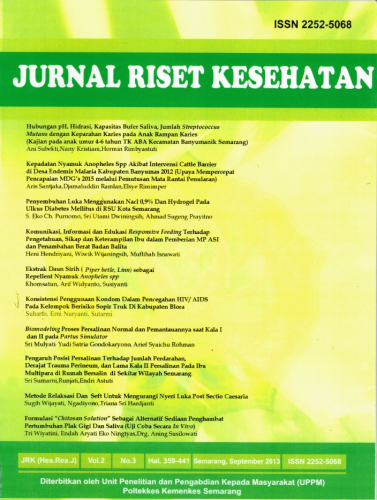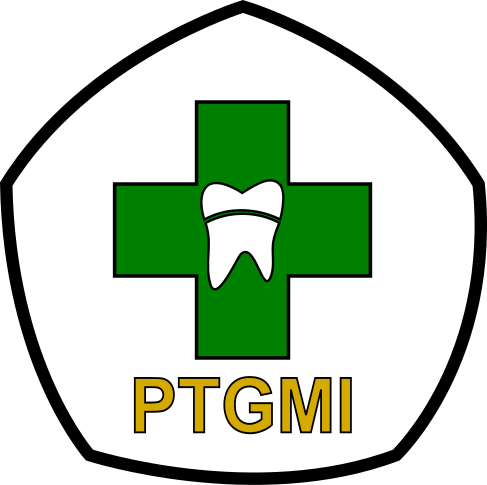THE EFFECTIVENESS OF MODERN DRESSING WITH A COMBINATION OF AFRICAN LEAF NANOPARTICLE HYDROGEL AND PAPUAN HONEY FOR GRADE II DIABETIC WOUND HEALING
Abstract
The combination of African leaf nanoparticle hydrogel (Vernonia amygdalina) and Papuan honey in modern dressing to heal wound in grade II diabetic patients can reduce the care day length and amputation risk for upper or lower extremity areas that are often affected and wounded in the event of hyperglycemia. Wound care is performed every 3 days for 20 days based on the physiological process in the proliferative phase of wound healing. The diabetic wound was assessed using the Bates Jensen Wound Assessment Tool (BWAT). The research was experimental with pre- and post-test control group design. The results showed that the 20-day wound care with this combination could reduce the BWAT score by 5.2, a sign of its effectiveness as compared to the control group reduction by 4.33. Conclusively, performing a modern dressing using this combination for 30-45 minutes every 3 days for 20 days was effective in accelerating the healing process of grade II diabetic wounds.
Keywords
Full Text:
PDFReferences
Djamanmona, R. F. EFEKTIFITAS MODERN DRESSING DENGAN HIDROGEL NANO PARTIKEL DAUN AFRIKA (VERNONIA AMYGDALINA) TERHADAP JUMLAH KOLONI BAKTERI DAN PENYEMBUHAN LUKA PADA PASIEN LUKA DIABETIK GRADE II.
Djamanmona, R. F., & Samaran, E. (2022). EFEKTIFITAS MIKRO PARTIKEL DAUN AFRIKA (VERNONIA AMYGDALINA) TERHADAP PENURUNAN KOLESTEROL PADA PASIEN DENGAN HIPERKOLESTEROL. Nursing Arts, 16(1), 46-52.
Egedigwe, C. A., Ijeh, II, Okafor, P. N., & Ejike, C. E. (2016). Aqueous and methanol extracts of Vernonia amygdalina leaves exert their anti-obesity effects through the modulation of appetite-regulatory hormones. Pharm Biol, 54(12), 3232-3236. doi: 10.1080/13880209.2016.1216135
Ijeh, I. I., & Ejike, C. E. (2011). Current perspectives on the medicinal potentials of Vernonia amygdalina Del. Journal of medicinal plants research, 5(7), 1051-1061.
Indonesia, P. E. (2015). Pengelolaan dan pencegahan diabetes melitus tipe 2 di Indonesia. Pb. Perkeni.
Kartika, R. W. (2015). Perawatan luka kronis dengan modern dressing. Cermin Dunia Kedokteran, 42(7), 546-550. doi: http://dx.doi.org/10.55175/cdk.v42i7.992
Kartika, R. W. (2017). Pengelolaan gangren kaki Diabetik. Cermin Dunia Kedokteran, 44(1), 18-22. doi: http://dx.doi.org/10.55175/cdk.v44i1
Merdekawati, D., & Az, R. (2017). Hubungan Prinsip Dan Jenis Balutan Dengan Penerapan Teknik Moist Wound Healing. Jurnal Endurance, 2(1), 90. doi: 10.22216/jen.v2i1.1658
Muawanah, A., & Wardhani, P. (2014). Aktivitas Antikanker dan Antioksidan Madu di Pasaran Lokal Indonesia. Jurnal Ilmu Pertanian Indonesia, 19(3), 136-144.
Mustakim, R., Suriadi, S., & Makmuriana, L. (2022). EFEKTIVITAS TERAPI BEKAM SUNNAH TERHADAP KADAR GULA DARAH SEWAKTU PADA PENDERITA DIABETES MELITUS RUMAH PERAWATAN LUKA STOMA INKONTINENSIA. Jurnal Keperawatan dan Kesehatan, 13(2), 1-6.
Prasetyo, D. Y. (2017). Pengaruh Perawatan Ulkus dengan Topical Dressing Hidrokoloid Kunyit (Curcuma Domestika) terhadap Proses Penyembuhan Ulkus Kaki Diabetik Stadium 2. Universitas Diponegoro Semarang.
Purnomo, S. E. C., Dwiningsih, S. U., & Lestari, K. P. (2014). Efektifitas Penyembuhan Luka Menggunakan Nacl 0, 9% dan Hydrogel Pada Ulkus Diabetes Mellitus di RSU Kota Semarang. Paper presented at the PROSIDING KONFERENSI NASIONAL II PPNI JAWA TENGAH 2014.
RI, K. K. (2018). Hasil Utama Riskesdas
Sundari, F., & Tjahjono, H. D. (2017). Pengaruh Terapi Madu Terhadap Luka Diabetik Pada Pasien Dengan Diabetes Mellitus Tipe 2 Di RW 011 Kelurahan Pegirian Surabaya. Jurnal Keperawatan, 6(1), 28-35.
Suriadi, S., Hastuti, L., & Handayani, L. W. (2015). Efektifitas Pemberian Madu Pinang Muda, Dan Jintan Hitam Dalam Proses Penyembuhan Luka Kronik Dengan Pseudomonas Aeruginosa Pada Tikus Putih. Jurnal Keperawatan dan Kesehatan, 6(1), 18-22.
DOI: https://doi.org/10.31983/jrk.v11i2.8883
Article Metrics
Refbacks
- There are currently no refbacks.
Copyright (c) 2022 Jurnal Riset Kesehatan




















































